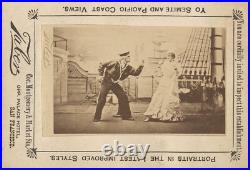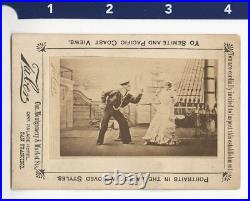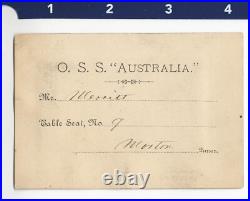




PHOTOGRAPHER : Charles Taber (see bio below). SUBJECT : This business card for photographer Charles Taber, which gives his San Francisco location. It was handed out to attendees of the stage play O. Australia’ (a play about the Australian gold rush occurring at the time). The business card front shows a scene from the play. The back of the card shows the play name, the attendee and their seat number. Taber provided photographs from the play and its actors for sale to attendees. SIZE : Business card measures. 3.875″ x 2.625″, mounted photo measures 2.875″ x 1.75″. Charles Taber was a renowned American photographer, best known for his work in the 19th century. He was active during the mid to late 1800s and became particularly famous for his portrait photography, capturing detailed images of individuals, groups, and landscapes. Taber was based in “New York City”, where he operated a successful studio and gained recognition for his technical skill and artistic approach to photography. Taber’s work emerged during a period when photography was rapidly evolving. He primarily used the “daguerreotype” process early in his career, which was one of the first commercial methods of creating photographic images. The daguerreotype was widely popular in the 1840s and 1850s but was eventually overshadowed by newer processes like the “albumen print” and “tin-type”, which allowed for more durable prints and greater accessibility to the public. By the time Taber established his name in the photographic community, the “albumen print” had become the standard, and his studio began producing high-quality prints on this medium. These prints became particularly popular for portraits, as they offered a sharp, detailed image and could be mass-produced. Taber’s photographic work covered a wide range of subjects, including “portraits of notable figures”, “historical events”, and “landscape photography”. He was known for his work in capturing images of the “American Civil War”, documenting soldiers, military leaders, and civilian life. His portrait sessions were marked by an ability to capture not just the likeness of his subjects but also their personalities, often highlighting their expressions or attire in a way that conveyed their social status or professional background. Throughout his career, Taber continued to experiment with photographic techniques. He embraced the evolving technology and became a pioneer in the development of “stereoscopic photography”, which produced 3D images when viewed through a special viewer. This format became incredibly popular during the latter half of the 19th century and was one of the most common forms of entertainment in American homes during the period. His studio produced thousands of stereographs, many of which were distributed widely across the United States. In addition to portrait photography, Taber was involved in creating “commercial photographs” for businesses, exhibitions, and public events. He often worked on large-scale projects, including the production of images for World’s Fairs and expositions, capturing not only the architecture and technology on display but also the people attending these major events. Despite the eventual rise of other photographers and the decline of some of the older photographic processes, Taber’s legacy continued to be felt well into the early 20th century. His contributions to both portrait and landscape photography made him a respected figure in the history of American photography, and his images remain valuable historical documents, providing insight into 19th-century American life.

